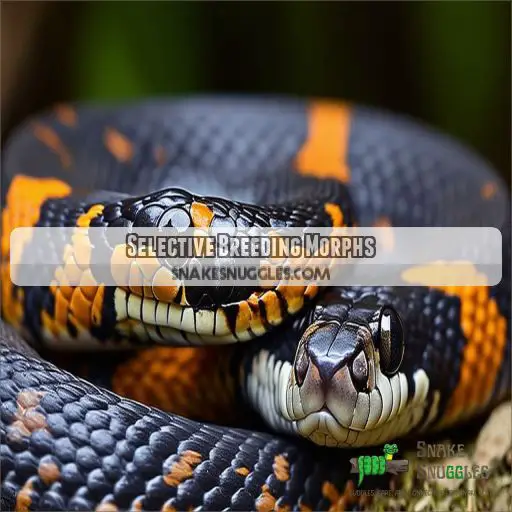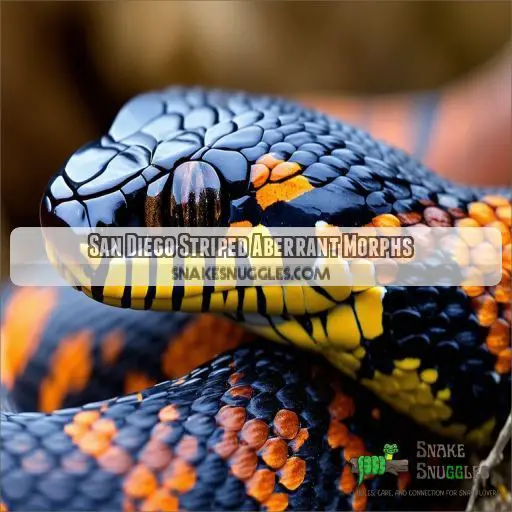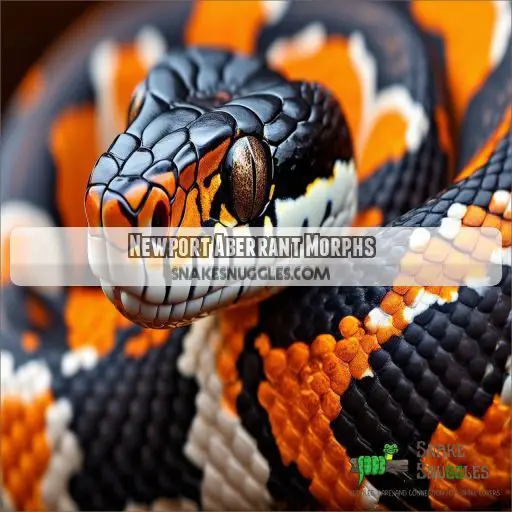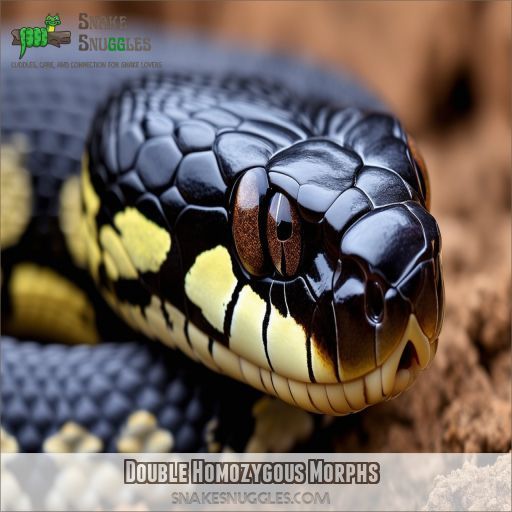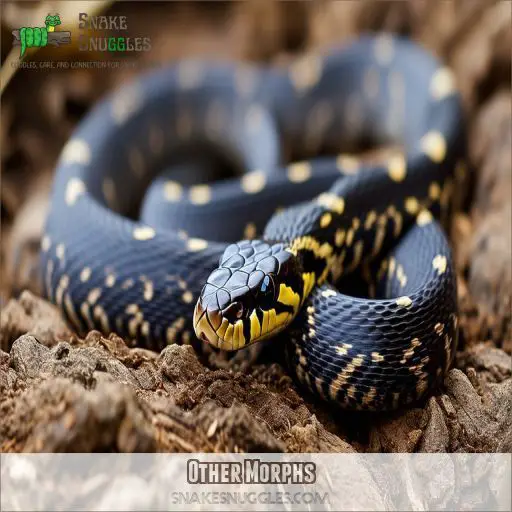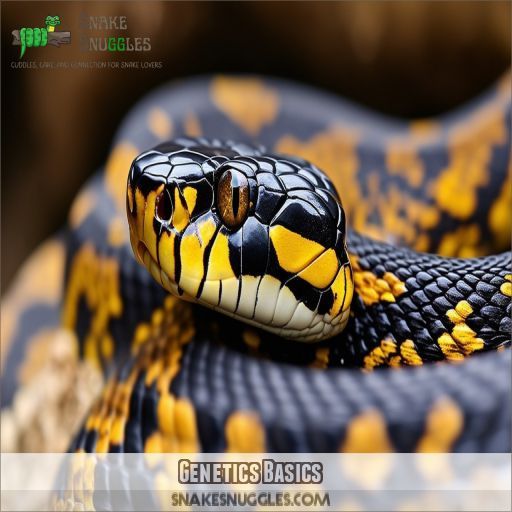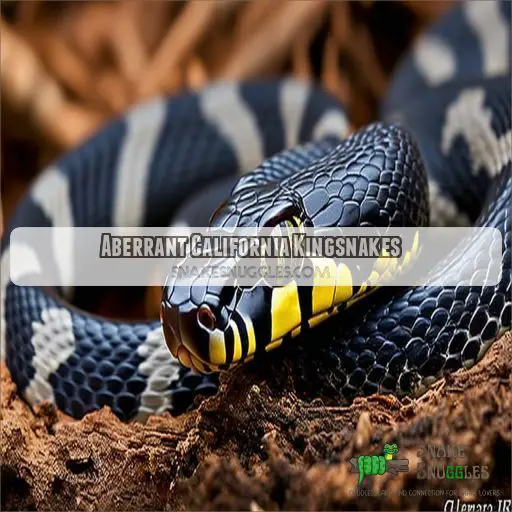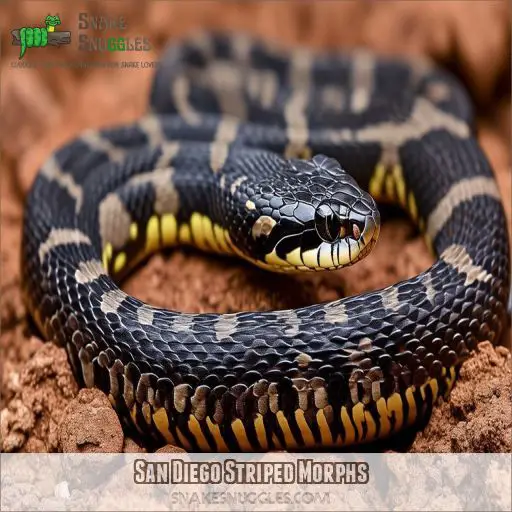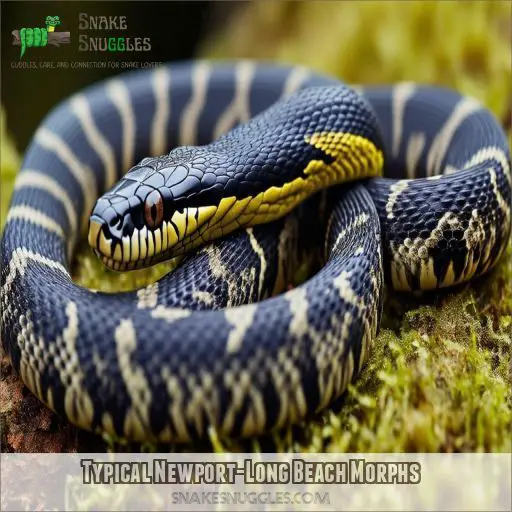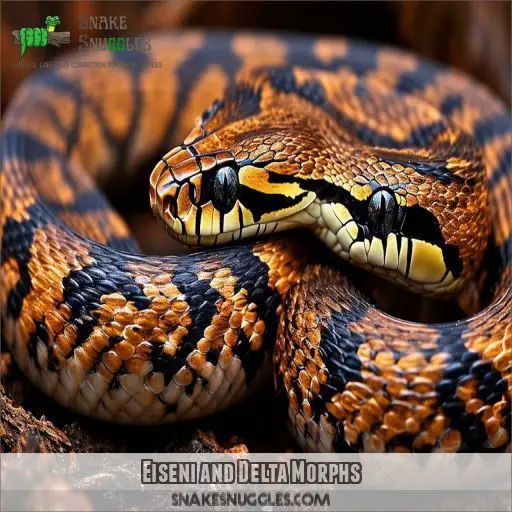This site is supported by our readers. We may earn a commission, at no cost to you, if you purchase through links.
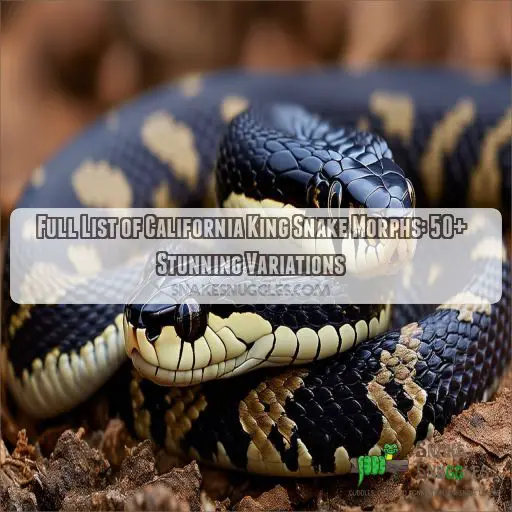 You’ll be amazed by the stunning variety of California king snake morphs. These snakes boast over 50 distinct color and pattern variations, from vibrant bananas to ethereal ghosts.
You’ll be amazed by the stunning variety of California king snake morphs. These snakes boast over 50 distinct color and pattern variations, from vibrant bananas to ethereal ghosts.
selective breeding has produced eye-catching morphs like BananaHigh White and Lavender Banana. San Diego Striped Aberrants include the mesmerizing Mosaic and Reverse Wide Stripe. Newport Aberrants showcase unique patterns like Carpet and Pin Striped.
Double Homozygous morphs feature striking combinations like Blizzard and Purple Passion. Other notable variations include Platinum, Palomar Ghost, and Scrambled Banded.
Each morph highlights the species’ genetic diversity and adaptability. Dive deeper to uncover the fascinating world of California king snake genetics and rare variations.
Table Of Contents
- Key Takeaways
- Selective Breeding Morphs
- San Diego Striped Aberrant Morphs
- Newport Aberrant Morphs
- Double Homozygous Morphs
- Other Morphs
- Genetics Basics
- Aberrant California Kingsnakes
- San Diego Striped Morphs
- Typical Newport-Long Beach Morphs
- Eiseni and Delta Morphs
- Frequently Asked Questions (FAQs)
- How many king snake morphs are there?
- Are there different types of California kingsnakes?
- How rare are California kingsnakes?
- What is a Hypermelanistic California kingsnake?
- What morph does a California King Snake have?
- How many California kingsnake morphs are there?
- Why do California kingsnakes have a brown morph?
- How do you identify a California King Snake?
- What is a California mountain kingsnake?
- Do California king snakes have melanistic morphs?
- How do temperature and humidity affect morph expression?
- Are there regional differences in morph frequency?
- Can diet influence the intensity of morph colors?
- Do morphs affect the snakes behavior or temperament?
- Are certain morphs more susceptible to health issues?
- Conclusion
Key Takeaways
- Get ready to be dazzled by the dazzling array of California king snake morphs – over 50 mesmerizing variations await your discovery!
- Dive into the world of selective breeding and uncover the secrets behind captivating morphs like Banana High White and Lavender Banana – it’s like a reptile fashion show!
- Explore the fascinating genetic tapestry of San Diego Striped Aberrant morphs, where unique patterns like Mosaic and Reverse Wide Stripe will leave you in awe.
- Double Homozygous morphs are the rockstars of the morph world, showcasing striking combinations like Blizzard and Purple Passion that will make your jaw drop.
Selective Breeding Morphs
You’ll find a wide array of California king snake morphs created through selective breeding, including the striking BananaHigh White and Lavender Banana varieties. Other popular selectively bred morphs include Twin Dotted, Twin Striped, and Reverse Striped, each showcasing unique pattern variations that captivate reptile enthusiasts.
BananaHigh White
You’ll be captivated by the BananaHigh White morph, a stunning result of selective breeding in California king snakes. This white morph showcases:
- Vibrant yellow-white body coloration
- Reduced or absent black banding
- Piercing red or pink eyes
- Potential for subtle lavender hues
BananaHigh White genetics combine albino and hypomelanistic traits, creating a snake that’s as visually striking as it’s rare. Breeding these morphs requires careful selection and understanding of recessive gene interactions.
Lavender Banana
You’ll find the Lavender Banana morph alluring with its unique blend of lavender and banana hues. This stunning variation results from selective breeding, combining lavender albino and chocolate banana genetics.
The snake’s patterns showcase a mesmerizing interplay of soft lavender tones and creamy banana shades.
Breeders often aim to enhance these colors, sometimes incorporating pink pearl ghost or chocolate ghost genes for added depth and complexity in the morph’s appearance.
Twin Dotted
Moving from the lavender banana, you’ll find the twin dotted morph equally alluring. This selective breeding marvel showcases:
- Distinctive double-dotted patterns
- Varying frequencies of twin dots along the body
- Unique inheritance patterns, often recessive
Twin dotting genetics can produce stunning variations in color patterns. You’ll notice how these morphs differ from their single-dotted counterparts, offering a mesmerizing display that sets them apart in the California king snake world.
Twin Striped
You’ll find the Twin Striped morph intriguing with its unique coloration patterns. This recessive trait, achieved through selective captive breeding, showcases two distinct stripes running along the snake’s body.
Unlike the Reverse Wide Stripe or Coral Ghost, Twin Striped California kingsnakes display a mesmerizing symmetry. Their genetic inheritance creates a stunning visual effect, rivaling even the Purple Passion or Sapphire Ghost morphs in beauty and rarity.
Reverse Striped
You’ll find the Reverse Striped morph equally enchanting. This genetic mutation flips the script on traditional banding, creating a stunning inverse pattern.
Unlike Twin Striped, Reverse Striped showcases a dominant light color with dark stripes. It’s a recessive trait, so breeding two carriers is key for morph expression.
This unique variation adds another layer to the fascinating world of California King Snake morphs and color variations.
San Diego Striped Aberrant Morphs
You’ll find that San Diego Striped Aberrant morphs display unique patterns that deviate from the typical striping of California king snakes. These variations include the Mosaic pattern with irregular shapes, Reverse Wide Stripe with bold inverted coloration, Reverse Dotted featuring scattered spots, and Vanishing Stripe where the stripe gradually fades along the snake’s body.
Mosaic
You’ll be mesmerized by the Mosaic morph, a stunning variation of the San Diego Striped Aberrant California Kingsnake. This unique pattern results from complex genetic interactions, creating a patchwork of colors and patterns across the snake’s body. Mosaic inheritance leads to unpredictable and often breathtaking variations, making each snake a one-of-a-kind masterpiece.
- Mosaic coloration resembles a living kaleidoscope
- Blizzard and Platinum genes can influence Mosaic patterns
- Het Palomar Ghost adds ethereal qualities to Mosaic variations
- Mosaic Palomar Ghost combines ghostly and patchwork effects
- No two Mosaic snakes are exactly alike
Reverse Wide Stripe
You’ll find the Reverse Wide Stripe morph alluring, with its striking inversion of the typical San Diego Striped pattern. This divergent variation boasts broader stripes than usual, creating a bold contrast.
The genetic inheritance of this trait offers fascinating breeding possibilities, allowing you to combine it with other morphs.
As you explore the full list of California King Snake morphs, you’ll discover how the Reverse Wide Stripe can lead to stunning variations like the vanishing stripe.
Reverse Dotted
You’ll find the Reverse Dotted morph, another fascinating San Diego Striped Aberrant variation, truly alluring.
Like its Wide Stripe cousin, this beauty flips the script on traditional banding. Instead of solid stripes, you’ll see a pattern of distinct dots running along the snake’s body.
This unique look stems from specific genetic traits, often found in coastal phase California kingsnakes.
Breeding these morphs requires careful selection and understanding of their inheritance patterns.
Vanishing Stripe
You’ve seen the reverse dotted, now let’s explore the vanishing stripe morph. This fascinating aberrant pattern showcases a gradual fading of the snake’s distinctive stripes. As you breed these beauties, you’ll notice:
- Mesmerizing yellow bands that seem to disappear
- Striking half-and-half patterns that’ll leave you in awe
- Pin-striped variations that’ll make your heart race
- Unique inheritance patterns that challenge your breeding skills
Mastering vanishing stripe genetics requires patience and expertise, but the results are truly alluring.
Newport Aberrant Morphs
You’ll find Newport Aberrant morphs to be some of the most visually striking California kingsnake variations. These morphs include the Carpet, Half and Half, Pin Striped, Hypermelanistic, and Chocolate patterns, each offering unique color and pattern combinations that captivate snake enthusiasts.
Carpet
You’ll find the Carpet morph among Newport Aberrant California kingsnakes, showcasing a unique blend of colors and patterns. This variation often displays a striking combination of dark and light scales, creating a textured appearance reminiscent of its namesake. Let’s explore the key features of the Carpet morph:
| Feature | Description |
|---|---|
| Colors | Ranges from charcoal to hypermelanistic |
| Patterns | Mosaic-like, irregular scales |
| Genetics | Complex inheritance, often recessive |
| Origin | Derived from Newport lineage |
Breeding Carpet morphs can be challenging but rewarding, offering snake enthusiasts a chance to master this enthralling variation.
Half and Half
You’ll find the Half and Half morph fascinating. This Newport Aberrant variation showcases a striking split coloration, often with black and white halves. It’s a result of unique pattern inheritance and selective breeding strategies.
Breeders aim for genetic diversity while maintaining morph compatibility. Unlike non-morphs, these snakes display stunning contrasts.
When breeding, consider pairing with other aberrants like the Joker or even a baby hypo mosaic kingsnake for intriguing results.
Pin Striped
Pin striped morphs, a standout among Newport aberrants, showcase thin, precise stripes running along their bodies. When breeding for pin striped patterns, focus on pin striped genetics, as selecting specific pairs increases your odds of success. These morphs thrive in desert habitats, eat a varied diet, and genetic selections make their docile nature perfect for enthusiasts.
Hypermelanistic
You’ll be captivated by the hypermelanistic California king snake morph. These stunning creatures showcase an excess of dark pigmentation, resulting in a glossy, almost black appearance.
Their genetics are complex, often producing unique patterns and variations. Breeding hypermelanistic morphs can lead to exciting combinations, like the dark phase ghost or sugar morph.
While not as extreme as some Florida kings, they’re still a powerful addition to any collection.
Chocolate
As you explore deeper into Newport Aberrant morphs, you’ll encounter the mesmerizing Chocolate variety. Unlike its hypermelanistic cousin, this morph showcases a rich, cocoa-like hue. The chocolate morph’s recessive gene creates a stunning dark coloration, often paired with a chocolate tail. Its genetic influence produces a snake that’s truly a sight to behold.
- Marvel at the velvety, cocoa-colored scales that seem to shimmer in the light.
- Imagine the envy of fellow snake enthusiasts when you showcase your rare chocolate California king.
- Picture the striking contrast between your chocolate morph and a light phase ghost or Brooks king snake.
Double Homozygous Morphs
Double homozygous morphs in California king snakes result from breeding two different recessive traits together. These unique combinations create stunning variations like the Blizzard, Joker, Purple Passion, Lavender Snow, and Chocolate Banana morphs, each displaying a distinctive blend of colors and patterns.
Blizzard
You’ll be amazed by the Blizzard morph, a double homozygous California kingsnake variant. Blizzard genetics combine two recessive traits, resulting in a stunning all-white appearance.
When breeding Blizzards, you’re working with complex genetic combinations. These snakes lack any visible patterns, making them truly unique.
While their appearance is striking, Blizzard kingsnakes still require the same habitat and care as their patterned counterparts.
Joker
You’ve seen the Blizzard, now let’s explore the Joker morph. This striking double homozygous variation showcases a unique blend of genetic traits. Joker California kingsnakes exhibit:
- Vibrant yellow and black patterns
- High contrast coloration
- Unpredictable stripe variations
- Potential for reduced black pigmentation
Joker genetics involve complex inheritance, requiring careful breeding strategies. When caring for Jokers, maintain proper humidity and temperature to guarantee their distinctive patterns shine. These snakes are true showstoppers in any collection.
Purple Passion
You’ve seen the Joker, now let’s explore the Purple Passion morph. This double homozygous beauty combines the lavender and pastel genes, resulting in a stunning purple hue.
Purple Passion genetics involve recessive traits, requiring careful breeding strategies. Their unique appearance has made them increasingly popular among enthusiasts.
While not as common as some morphs, Purple Passion California Kingsnakes are becoming more available through specialized breeders.
Lavender Snow
You’ll be captivated by the Lavender Snow morph, a stunning double homozygous variation. This ethereal snake combines two recessive genes:
- Lavender albino
- Snow (amelanistic and anerythristic)
- Visual traits include pale lavender body
- Pink to red eyes
Breeding these beauties requires careful genetic planning. You’ll master the science of selective breeding, acquiring the ability to create these ghostly serpents. Their unique coloration sets them apart, making them a prized possession for any snake enthusiast.
Chocolate Banana
You’ve marveled at the Lavender Snow, now let’s explore the Chocolate Banana morph. This double homozygous beauty combines the rich, cocoa hues of the Chocolate gene with the vibrant yellows of the Banana trait.
It’s a demonstration of the power of genetic inheritance and co-dominant interactions. Breeders have mastered the art of creating these stunning pattern variations and color combinations.
You’ll be captivated by its unique blend of warm, earthy tones and bright, sunny highlights.
Other Morphs
You’ll find several other striking California king snake morphs beyond the common categories. These include the gleaming Platinum, the ethereal Palomar Ghost, Dark and Light Phase Ghosts, and the elusive Casper Ghost, each offering unique color patterns and visual appeal.
Platinum
You’ll be captivated by the platinum California king snake morph. This stunning variation showcases a silvery-white coloration that’s truly mesmerizing. Platinum morphs result from selective breeding, emphasizing the reduction of yellow pigmentation. When you’re exploring platinum genetics, you’ll find they’re often combined with other traits to create even more striking variations.
- Marvel at the snake’s otherworldly sheen
- Feel the excitement of owning a living piece of art
- Experience the thrill of mastering platinum breeding
- Embrace the power of manipulating genetics for beauty
Palomar Ghost
You’ll find the Palomar ghost morph an intriguing variation in California kingsnakes. This rare genetic mutation produces a stunning, pale appearance with subtle pattern variations.
Unlike other ghost morphs, Palomar ghosts inherit their unique coloration through a specific combination of genes. You’ll notice their ethereal beauty, characterized by muted tones and softened patterns.
Breeding Palomar ghosts can be challenging, but the results are truly mesmerizing for enthusiasts seeking mastery in kingsnake genetics.
Dark Phase Ghost
Moving from the Palomar Ghost, let’s delve into the Dark Phase Ghost. This striking morph exemplifies the power of genetics in California kingsnakes.
You’ll find these beauties with markedly darker coloration, a result of increased melanin production. While not as prevalent as their lighter counterparts, Dark Phase Ghosts are highly sought after by enthusiasts.
Their distinctive appearance serves as a testament to the significance of genetic diversity in conservation efforts and habitat preservation.
Light Phase Ghost
Now, switching gears to the Light Phase Ghost morph. This paler variant of the ghost morph has a striking pale appearance.
You’ll find ghost morphs like these thriving well in various habitats. Their diet typically includes rodents and other small prey.
Regarding ghost morph inheritance, Light Phase Ghosts require strategic breeding practices to maintain their distinctive pallor.
Lifespan parallels other morphs, ensuring long-term fascination.
Casper Ghost
You’ll be captivated by the Casper ghost morph, a truly ethereal variation of the California king snake. Its ghostly appearance is the result of complex genetics, combining albino and hypomelanistic traits.
The Casper’s morphology features a pale, almost translucent body with subtle patterns.
While stunning, this morph requires specialized care and habitat considerations. Mastering the Casper’s needs will give you a sense of power over one of nature’s most intriguing genetic marvels.
Genetics Basics
To understand the diverse morphs of California king snakes, you need to grasp the basics of genetics. We’ll explore dominant and recessive genes, incomplete dominance, and the roles of albino and hypomelanistic genes in creating these stunning variations.
Dominant and Recessive Genes
Shifting from unique morphs, let’s explore the genetics that underpin these remarkable variations. In the realm of dominant and recessive genes in California king snakes, consider the following:
- Dominant genes manifest even with one copy
- Recessive genes demand two copies for expression
- Breeding dominant to recessive produces exclusively heterozygous offspring
- Two heterozygotes yield 25% normal, 50% heterozygous, and 25% recessive
Grasping these inheritance patterns is crucial for mastering selective breeding and realizing the snake’s genetic potential.
Incomplete Dominance
You’ve learned about dominant and recessive genes, but there’s another type of genetic inheritance: incomplete dominance. This fascinating mechanism creates a blend of traits in California king snakes. It’s like mixing paint colors – you get something in between. Let’s explore how incomplete dominance affects morph expression:
| Parent 1 | Parent 2 | Offspring |
|---|---|---|
| Normal | Incomplete | All het |
| Incomplete | Incomplete | Range of phenotypes |
| Incomplete | Recessive | Intermediate coloration |
Double homozygotes express both recessive genes, creating unique morphs like the stunning Lavender Snow.
Albino and Hypomelanistic Genes
You’ll find albino genes intriguing in California King Snakes. They block melanin production, resulting in white or lavender snakes with pink eyes.
Hypomelanistic genes, on the other hand, reduce melanin, creating lighter-colored morphs. Both are recessive, requiring two copies for expression.
Notably, different albino genes exist, and some aren’t compatible. Hypomelanistic gene expression varies in intensity, offering a wide range of stunning morphs.
Mastering these genetics unveils a world of captivating snake variations.
Aberrant California Kingsnakes
You’ll find that aberrant California kingsnakes exhibit unique patterns due to genetic variations, with the Newport morph being a prime example. The Scrambled Banded morph is a highly variable Newport variant, while the Chocolate Back Newport features a reduced stripe and distinctive chocolate-colored tail.
Newport Morph
You’ll find the Newport morph captivating, with its unique aberrant patterns that enthrall snake enthusiasts. These California kingsnakes display:
- Highly variable stripe patterns
- Diverse color combinations
- Increased melanin production
When breeding Newport morphs, prioritize genetic diversity and ethical practices. Health should be your chief concern. By mastering Newport patterns, you’ll open a realm of stunning variations. Remember, responsible breeding strategies guarantee the well-being of these magnificent creatures while safeguarding their genetic richness.
Scrambled Banded Morph
The Scrambled Banded morph, a wild-caught aberrant California Kingsnake, can be found in coastal Los Angeles County. This rare gem showcases a unique pattern that’s like nature’s abstract art.
Its origin and habitat remain a mystery, but captive breeding has proven viable. The color pattern inheritance is complex, making each specimen a one-of-a-kind masterpiece.
It’s a morph that will have you marveling at nature’s creativity.
Chocolate Back Newport
You’ve seen the Scrambled Banded morph, now let’s delve into the Chocolate Back Newport. This rare aberrant morph showcases a reduced stripe and distinctive chocolate-colored tail.
It’s a product of unique breeding patterns and recessive genes. You’ll notice the stark contrast between the lighter body and the rich, cocoa-hued tail.
Mastering these genetics can lead to some truly stunning snakes in your collection.
San Diego Striped Morphs
You’ll find a fascinating array of San Diego Striped morphs among California kingsnakes, including the Juvenile Highway Stripe, Stripe-Blotch-Stripe, Juvenile Stripe-Band-Stripe, and Adult Dotted variations. These morphs showcase unique stripe patterns and color distributions, ranging from continuous highway-like stripes to intricate combinations of stripes, blotches, and bands.
Juvenile Highway Stripe Morph
The Juvenile Highway Stripe morph, a stunning variation of the San Diego Striped Aberrant, can be found in Riverside County.
This young snake showcases a distinctive pattern that will catch your eye. Its banding influence creates a mesmerizing stripe resembling a highway, hence the name.
It’s a prime example of nature’s artistry, giving you a glimpse into the diverse world of California kingsnake morphs.
Stripe-Blotch-Stripe Morph
You’ll find the Stripe-Blotch-Stripe morph equally enthralling. This rare coastal variation showcases a unique interplay of stripes and blotches.
Unlike the Highway Stripe, you’ll notice a distinct blotch stripe pattern interrupting the continuous stripes. This morph’s band influence creates a mesmerizing effect, with blotches sandwiched between bold stripes.
It’s a testament to the California King Snake’s genetic diversity and nature’s artistic flair.
Juvenile Stripe-Band-Stripe Morph
You’ll find the juvenile stripe-band-stripe morph enchanting with its unique pattern. This San Diego County variant showcases alternating stripes and bands, a proof of the complex morph genetics at play.
The aberrant patterns can vary in band count, creating a mesmerizing effect. Found in coastal California, these snakes display nature’s artistry.
You’ll be amazed at how this morph’s appearance evolves as it matures, revealing the intricate beauty of juvenile stripes.
Adult Dotted Morph
You’ve seen the striking Stripe-Band-Stripe morph, now let’s explore the Adult Dotted morph.
Found in San Diego and Riverside Counties, this unique variant showcases a fascinating pattern. Instead of continuous stripes, you’ll notice a series of dots along the snake’s body. These dots create a broken stripe effect, giving the snake a distinctive appearance.
The dotted pattern varies in intensity, making each specimen a one-of-a-kind beauty in the California Kingsnake family.
Typical Newport-Long Beach Morphs
You’ll find Newport-Long Beach morphs in stunning variations like the bright yellow morph, which stands out with its vibrant coloration. The juvenile barred and scrambled banded morphs showcase unique pattern variations, with the barred morph displaying distinct horizontal bands and the scrambled banded morph exhibiting a more irregular, mixed pattern.
Bright Yellow Morph
You’ll be amazed by the bright yellow morph, a stunning variation of the typical Newport-Long Beach California kingsnake. Found in coastal Los Angeles, this subspecies showcases the incredible genetic diversity within the species.
Its vibrant coloration sets it apart, making it a prized possession for snake enthusiasts.
The bright yellow morph exemplifies how geographic variation can lead to breathtaking results in nature’s palette.
Juvenile Barred Morph
You’ll find the juvenile barred morph equally intriguing. Unlike its bright yellow cousin, this Newport-Long Beach variant sports distinctive barred patterns.
These young snakes showcase hypomelanistic banded variations, with narrow, banded segments along their bodies. The juvenile coloration often features a mix of light and dark bars, creating a striking contrast.
As they mature, you’ll witness these patterns evolve, offering a fascinating glimpse into the snake’s development.
Juvenile Scrambled Banded Morph
You’ll be astonished by the juvenile Scrambled Banded morph, a wild-caught variant from coastal Los Angeles County. This Newport-Long Beach morph showcases incredible genetic variation, with its aberrant banding pattern breaking all the rules. As you observe its juvenile coloration, you’ll notice:
- Irregular, zigzagging bands that seem to defy logic
- A mesmerizing mix of light and dark scales
- Unique patterns that evolve as the snake matures
- Possible environmental influence on morph development
This intriguing morph exemplifies nature’s artistry, offering a glimpse into the complex world of snake genetics.
Eiseni and Delta Morphs
Eiseni and Delta Morphs showcase unique and intriguing patterns found in California king snakes. You’ll find the Valley Phase morph, Central Valley Black-bellied Eiseni morph, adult speckled or washboard morph, and Delta Aberrant morph, each carrying distinct features.
Valley Phase Morph
You’ll find the Valley Phase morph a striking variant of California kingsnakes. This unique pattern showcases a stunning blend of traditional and aberrant features.
The snake’s coloration typically includes a lighter background with darker bands or blotches. As you observe this morph, you’ll notice how the valley influence creates a mesmerizing interplay of light and dark.
The Valley Phase morph is a prized possession for snake enthusiasts seeking mastery over rare morphs.
Central Valley Black-bellied Eiseni Morph
The Central Valley Black-bellied Eiseni morph is a true marvel. Originating from Fresno County, this snake boasts a distinctive black underside, setting it apart from the typical valley phase morphs. Its dark belly contrasts sharply with its lighter dorsal coloration, often speckled or patterned in a washboard fashion, making it a standout in any collection.
Adult Speckled or Washboard Morph
The adult speckled or washboard morph captivates with its unique coloration. This morph displays a striking speckled pattern, characterized by irregular blotches that can vary in intensity and hue. The "washboard pattern" creates an eye-catching mosaic on its scales, making these snakes stand out visually. Perfect for enthusiasts seeking a distinctive and mesmerizing addition to their collection.
Delta Aberrant Morph
You’ll find the Delta Aberrant morph striking with its unique blend of Delta pattern and aberrant traits. This rare variation showcases irregular banding and unexpected color shifts. Inherited through complex genetic combinations, it’s a demonstration of nature’s artistry.
You’ll notice its distinctive characteristics: unpredictable stripe interruptions, scattered scales of contrasting hues, and an overall asymmetrical appearance.
It’s like a living canvas, each specimen a one-of-a-kind masterpiece.
Frequently Asked Questions (FAQs)
How many king snake morphs are there?
Picture a kaleidoscope of scales! You’ll find over 30 distinct California king snake morphs. From albinos to chocolates, each variation’s a masterpiece of nature. Explore this serpentine world and you’ll discover an incredible array of patterns and colors.
Are there different types of California kingsnakes?
Yes, you’ll find various California kingsnake types. They come in different patterns and colors, including banded, striped, and aberrant morphs. You’ll see variations like the San Diego Striped, Newport Aberrant, and Delta morph, each with unique characteristics.
How rare are California kingsnakes?
California kingsnakes aren’t rare in their native range. You’ll find them throughout the state, from coastal areas to deserts. They’re adaptable and widespread, but some morphs are less common. Their popularity in the pet trade remains high.
What is a Hypermelanistic California kingsnake?
A Hypermelanistic California kingsnake exhibits excessive black pigmentation, resulting in a darker appearance than typical specimens. You’ll notice reduced pattern visibility and an overall sleek, jet-black look. This striking morph is highly sought after by reptile enthusiasts.
What morph does a California King Snake have?
You’ll find California kingsnakes in various morphs, including albino, striped, and banded patterns. They can sport colors like black, white, brown, or even lavender. Each snake’s unique genetic makeup determines its specific morph and appearance.
How many California kingsnake morphs are there?
You’ll find a vast array of California kingsnake morphs, with over 30 recognized variations. These include selective breeding types, San Diego Striped Aberrants, Newport Aberrants, Double Homozygous morphs, and other unique patterns. Each morph showcases nature’s incredible genetic diversity.
Why do California kingsnakes have a brown morph?
California kingsnakes’ brown morph isn’t a separate mutation, but a natural color variation. It’s evolved to blend with their environment, providing camouflage against predators and prey. This adaptation helps them survive and thrive in diverse habitats.
How do you identify a California King Snake?
Like a jewel-encrusted serpent, you’ll spot a California kingsnake by its distinct bands. Look for alternating black and white rings encircling its body. You’ll notice a sleek, slender form and smooth scales. Their heads are slightly wider than their necks.
What is a California mountain kingsnake?
A California mountain kingsnake, Lampropeltis zonata, displays distinctive red, black, and white or yellow bands. It inhabits forested and rocky areas in the western United States and preys on other reptiles, small mammals, and birds.
Do California king snakes have melanistic morphs?
Yes, California king snakes have melanistic morphs. You’ll find these striking black variants in certain populations. They’re the result of increased melanin production, creating a sleek, dark appearance that’s quite different from typical patterns.
How do temperature and humidity affect morph expression?
Temperature and humidity can substantially affect morph expression in California king snakes. You’ll notice that cooler temps often result in darker colors, while higher humidity may enhance pattern clarity. These factors can influence gene expression during development.
Are there regional differences in morph frequency?
Yes, you’ll find regional differences in morph frequency. Coastal areas often have more striped morphs, while inland regions show higher rates of banded patterns. Climate, habitat, and genetic isolation contribute to these variations across California’s diverse landscapes.
Can diet influence the intensity of morph colors?
You can influence morph colors through diet, but it’s not a magic wand. Carotenoid-rich foods may enhance yellows and reds, while a balanced diet supports overall health and vibrancy. Genetics still play the starring role in color intensity.
Do morphs affect the snakes behavior or temperament?
You’ll find that morphs don’t typically affect a snake’s behavior or temperament. Their genetic differences mainly influence appearance, not personality. However, individual snakes may vary in temperament regardless of their morph type.
Are certain morphs more susceptible to health issues?
Yes, certain morphs can be more prone to health issues. For instance, albino morphs may have vision problems due to lack of melanin, and inbreeding for rare morphs can increase the risk of genetic defects.
Conclusion
Astoundingly, the exhaustive list of California king snake morphs showcases over 50 stunning variations, from the vibrant Banana High White to the ethereal Palomar Ghost.
This genetic diversity highlights the species’ remarkable adaptability.
Whether you’re enthralled by the mesmerizing Mosaic or intrigued by the Blizzard’s striking combination, the universe of California king snake morphs offers a truly engaging exploration of this reptile’s remarkable versatility.
Dive deeper into this exhaustive list of California king snake morphs to uncover the fascinating genetic wonders of this remarkable species.

